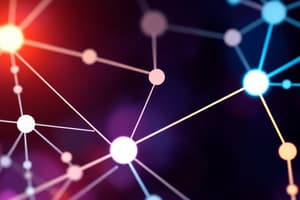Podcast
Questions and Answers
What is the primary purpose of networking?
What is the primary purpose of networking?
To enable the sharing of resources and information among devices.
Which layer of the OSI model deals with the physical connection between devices?
Which layer of the OSI model deals with the physical connection between devices?
- Data Link Layer
- Physical Layer (correct)
- Transport Layer
- Network Layer
Centralized data storage in networks makes it harder to manage and back up data.
Centralized data storage in networks makes it harder to manage and back up data.
False (B)
In networking, a _____ is a device connected to a network, such as a computer or printer.
In networking, a _____ is a device connected to a network, such as a computer or printer.
Match the following layers of the OSI model with their descriptions:
Match the following layers of the OSI model with their descriptions:
Which of the following is a benefit of networking?
Which of the following is a benefit of networking?
What does TCP/IP stand for?
What does TCP/IP stand for?
What is the disadvantage of a Bus Topology?
What is the disadvantage of a Bus Topology?
Flashcards are hidden until you start studying
Study Notes
Networking Overview
- Networking connects computers and devices for resource sharing, such as data, applications, and hardware (printers, scanners).
Key Concepts in Networking
- Nodes: Connected devices like computers and printers.
- Links: Physical or wireless connections that enable data transmission between nodes.
- Data: Information exchanged, including text, images, and videos.
Purpose and Benefits of Networking
- Primary Purpose: Enables sharing of resources and information among devices.
- Resource Sharing: Multiple users can access shared resources, reducing the need for individual copies.
- Communication: Facilitates emails, instant messaging, voice calls, and video conferencing.
- Data Management: Centralizes data, making management, backup, and security more efficient.
- Scalability: Networks can grow by adding devices, supporting business expansion.
- Cost Efficiency: Reduces costs by sharing resources.
Open Systems Interconnection (OSI) Model
- A standardized conceptual framework with seven layers, each defining specific networking functions:
- Layer 1: Physical Layer: Focuses on the physical connection between devices (e.g., Ethernet cables, fiber optics).
- Layer 2: Data Link Layer: Manages node-to-node data transfer, error detection, and correction (e.g., MAC addresses, Ethernet).
- Layer 3: Network Layer: Handles routing of data packets across networks (e.g., IP addresses, routers).
- Layer 4: Transport Layer: Ensures complete data transfer with error checking and flow control (e.g., TCP, UDP).
- Layer 5: Session Layer: Manages sessions or connections between applications (e.g., network file sharing).
- Layer 6: Presentation Layer: Translates data between application and lower layers (e.g., SSL encryption).
- Layer 7: Application Layer: Closest to end-user, responsible for network services for applications (e.g., HTTP, SMTP, FTP).
TCP/IP Model Overview
- A four-layer framework foundational for the internet and modern networks:
- Layer 1: Network Interface Layer: Combines OSI's physical and data link layers (e.g., Ethernet, Wi-Fi).
- Layer 2: Internet Layer: Corresponds to the OSI network layer (e.g., IP, ICMP).
- Layer 3: Transport Layer: Handles end-to-end communication ensuring data integrity (e.g., TCP, UDP).
- Layer 4: Application Layer: Merges OSI's application, presentation, and session layers offering services directly to applications (supports HTTP, FTP, SMTP, DNS).
Network Topologies
- Network Topology: Arrangement of devices in a network:
- Bus Topology: All devices share a single communication line.
- Advantages: Simple implementation, cost-effective for small networks.
- Disadvantages: Failure in the main cable disrupts the entire network.
- Example: Early Ethernet networks.
- Star Topology: Devices connect to a central hub, switch, or router.
- Advantages: Robust against individual device failures.
- Disadvantages: The central device failure can bring down the entire network.
- Bus Topology: All devices share a single communication line.
Studying That Suits You
Use AI to generate personalized quizzes and flashcards to suit your learning preferences.




